|
1808 - 1815 The Start
The Highland
Society of London launched an appeal in 1808 to raise
money for an Asylum to house and educate the many young Scots who were
roaming the streets of London, having been orphaned by the Napoleonic
wars. It took seven years to raise sufficient funds and to prepare the
necessary Act of Parliament needed to create the Asylum.
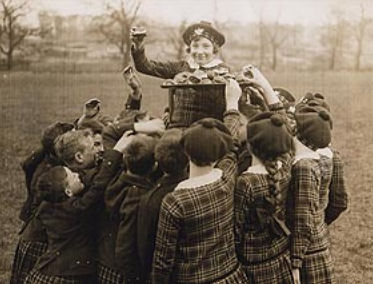
Caley
kids enjoying scones
Finally, on 14 June 1815, The
Caledonian Asylum was launched by Act of Parliament. The original Life
Guardians included their Royal Highnesses Frederick, Duke of York and
Albany, Edward Duke of Kent and Strathearn, Augustus Frederick, Duke
of Sussex and Earl of Inverness.
Others included the Dukes
of Marlborough, Buccleuch and Queensbury, Gordon, Argyll, Montrose,
Roxburgh, and Arthur Wellesley, Duke of Wellington.
1815 - 1903 The Asylum and the Road
Following its incorporation the Guardians started
the long process of finding a site for the Asylum. In March 1819
the first six boys were elected and six good London women were paid a
shilling (5p in today's currency) a week to care for them.
The first Asylum
was opened in December 1819 in Hatton
Garden and was replaced in 1826 by a
newly built Asylum in Copenhagen Fields, Islington. It remained there
for 77 years and lent its name to the "Caledonian Road".
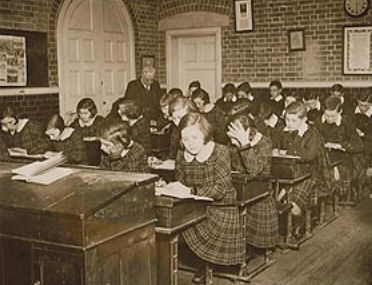
Children in a Caley school room
Initially the scholars were all boys but in
1844,
following some alterations, a space was found in the Asylum for a new
school for girls.
In 1852 Her
Majesty Queen Victoria became Patron and the Asylum was renamed the
Royal Caledonian Schools, although legally it was and still is the
"Caledonian Asylum". Royal patronage has continued since then.
When the Asylum was built in 1826
Islington was a quiet little village but by the end of the century
things had changed. On 12 December 1901 the
London Correspondent of the Aberdeen Daily Chronicle wrote:
"The Immediate
neighbourhood is not pleasant. Cheek by jowl with the Asylum sits
Pentonville Prison whose precincts have been darkened by the worse
criminals the nation affords, and around it gathers the scum of all
the nation on earth. Indeed one might walk the whole length of the
Caledonian Road from Kings Cross to Holloway and Holloway again for a
day and see nothing that his eye could rest on with pleasure except
perhaps the "weel-faured" faces of the boys and girls of the Asylum in
their dainty highland dresses."
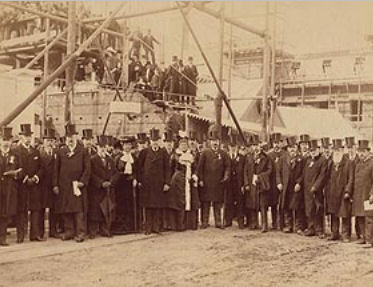
Topping out ceremony at Bushey
Concerns like this
had already lead to the Directors deciding to find a new site. By the
end of 1897
they had decided to move to Bushey in Hertfordshire. Eventually after
various appeals £37,400 was raised and the new schools project was up
and moving. Part of the money came from the London County Council who
purchased the old Asylum for £16,000, demolished it and built flats.
These flats still remain and our history is remembered on the gates
which are adorned with thistles.
1903 - 1996 The Bushey Years
The School in Bushey, which still stands in Aldenham Road, cost
£40,000 and was built by Kerridge & Shaw of Cambridge. The architect
was William Emerson, the then President of the Royal Institute of
British Architects.
The Memorial Stone for the new Building was laid
on 10 May 1902
by Her Royal Highness the Princess Beatrice, Princess Henry of
Battenberg, a glittering occasion with great ceremony.
Later that month Bushey
saw another procession when the children arrived from London by train
and marched from Bushey Station led, of course, by the Schools' pipes
and drums.
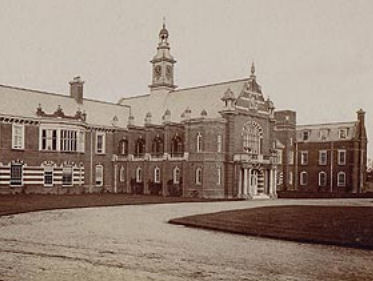
The Schools, with the Chapel which was
destroyed during the Second
World War.
It was through the pipes and drums that the Schools left their
permanent impression in Bushey with regular church parades and at
local ceremonies. For many years the Caley Pipes and Drums played
their part in Armistice Day commemorations at the Bushey war memorial.
With many Caley scholars joining the armed forces
it is believed that ex-Caleys will have played their part in virtually
every armed conflict since 1835. Caley
lives were lost in both the First and Second World Wars. During the
Second World War the dining room was damaged due to enemy action and
the school chapel was destroyed due to an electrical fault.
From 1903 to 1948
education was provided at the Schools. The regime was strict but the
children received a good Scottish education. After 1948
the children attended local state schools.
Many royal visits to the Schools took place. In
1925
the Prince of Wales who later became King Edward VIII visited the
Schools, and the following year the Duke & Duchess of York (who later
became King George VI and Queen Elizabeth) came to present prizes.
This was the beginning of a long association with the Schools for
Queen Elizabeth who as Queen Mother made two further visits and always
took a real interest in the work of the schools.
In 1986
our present Patron Her Majesty the Queen opened Coltart House, the
then new 6th Form accommodation.
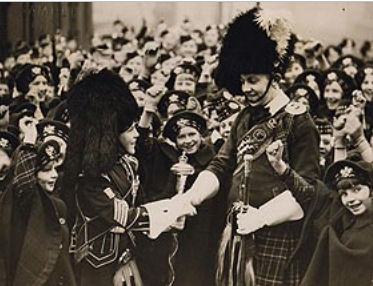
Pipe majors of the future
By 1995 the
Directors, having given consideration both to the future of the
Schools and the wishes of the original founders, decided that the best
way to continue their work into the 21st century would be to close the
Bushey premises, sell them and invest the proceeds of sale to provide
an income for a new Educational Trust.
The buildings were
purchased by the Purcell School, one of the four principle music
schools in the UK, so music continues to grace these important
buildings - only now the pipes and drums have been exchanged for other
classical instruments.
1996 - and onwards
Since the educational trust was formed we have helped hundreds of
young Scots and awarded over one million pounds in grants. A whole new
generation of Caley Scholars is emerging.
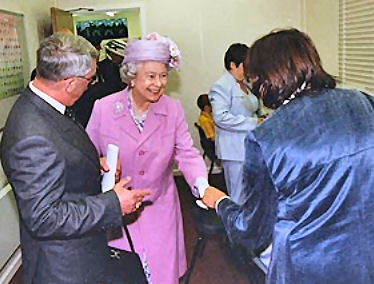
Her Majesty The Queen, our patron, opens
"The
Hub" in Inverness, we co-ordinated the
fundraising for this project.
Our links with the Armed
Forces remain strong and we have recently launched an educational
project which continues our work in helping to alleviate the effects
on service children caused by the moves required of their parents.
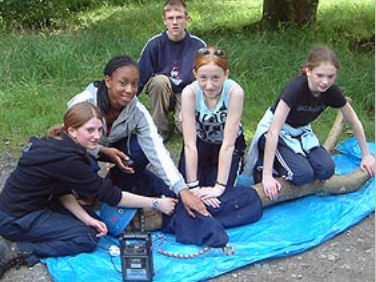
Children enjoying the Adventure Welfare
Services
2004 Summer Camp
Chloe Gardner
Royal Caledonian Schools Trust
Unit 75 WENTA Business Park
Colne Way
Watford
Herts WD24 7ND
Tel: 01923 215350
Fax: 01923 215354
Website:
www.rcst.org.uk
Press Release
May 2010
‘The Unseen Victims of
War’
Research
desperately needed to find service children in Scottish schools.
There are an estimated
175,000 service children in the UK and this figure is rising as more
parents engage in service in Afghanistan. With media coverage of the
war at all time high, is anyone thinking about the impact of war on
Scotland’s service children?
New studies into the impact
of the war on children have addressed the long-term behavioural
problems that families and schools now have to deal with as a result
of:
• Impact on
child of living in a one-parent family for
significant periods of time
• Influence
of the media
•
Adjustments to family life when the parent returns
• Impact of
moving homes, schools and communities
• Stigma of
being a ‘Service child’
• Dealing
with bereavement
•
Dealing with parental illness or injury
• Dealing
with divorce and family breakdown
There are no official
statistics on how many Scottish service children there are and where
they are based. Carolyn MacLeod from the Royal Schools
Caledonian Trust states the Government’s lack of available information
on how many Scottish children are affected by the war is “not good
enough. It is imperative for Scotland to have tangible research
on the number of service children in their schools to identify, locate
and support them to achieve at such a turbulent time."
The Trust's Education
Wellbeing Project, one which has been recently launched in Fife; is
one of the ways they are supporting service. children.
This project aims to educate teachers about the impact of war on
service children and supply tools to enable them to deal effectively
with children who are affected by the war. The 18 members of the
project, including teachers, educational psychologists and service
personnel feel that the project will enable them to offer more support
to these vulnerable children.
Carolyn MacLeod goes on to
say that "each service child should have a 'passport' so that if they
are relocated, the new school can see at a glance a progress report
instead of a child having to constantly re-sit entry exams. Each
school should have training and systems in place to help service
families and most importantly schools should have a 'critical plan' in
response to tragedy."
The Royal Caledonian Schools Trust was
established nearly 200 years ago to help educate the sons and
daughters of Scots who were serving. It is a crucial time for
the charity, but with the help of Scotland we can succeed in our
mission to support Scottish service children.
If you would like more
information on this topic or to schedule an interview with Carolyn
MacLeod, please call Chloe on 07900 210472.
Pictures available on
request.
Chloe Gardner
|

